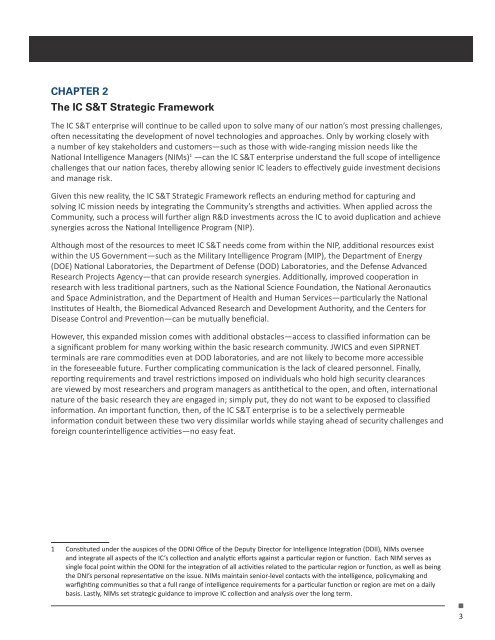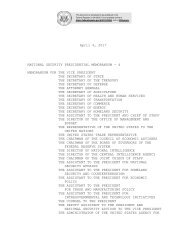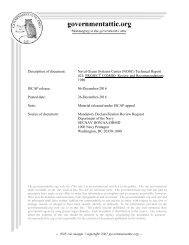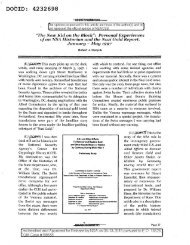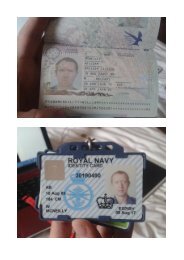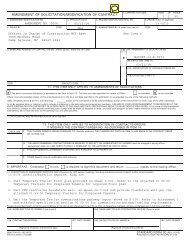IC S&T STRATEGIC PLAN
dni-sci-tech-2016-20-plan
dni-sci-tech-2016-20-plan
Create successful ePaper yourself
Turn your PDF publications into a flip-book with our unique Google optimized e-Paper software.
CHAPTER 2The <strong>IC</strong> S&T Strategic FrameworkThe <strong>IC</strong> S&T enterprise will continue to be called upon to solve many of our nation’s most pressing challenges,often necessitating the development of novel technologies and approaches. Only by working closely witha number of key stakeholders and customers—such as those with wide-ranging mission needs like theNational Intelligence Managers (NIMs) 1 —can the <strong>IC</strong> S&T enterprise understand the full scope of intelligencechallenges that our nation faces, thereby allowing senior <strong>IC</strong> leaders to effectively guide investment decisionsand manage risk.Given this new reality, the <strong>IC</strong> S&T Strategic Framework reflects an enduring method for capturing andsolving <strong>IC</strong> mission needs by integrating the Community’s strengths and activities. When applied across theCommunity, such a process will further align R&D investments across the <strong>IC</strong> to avoid duplication and achievesynergies across the National Intelligence Program (NIP).Although most of the resources to meet <strong>IC</strong> S&T needs come from within the NIP, additional resources existwithin the US Government—such as the Military Intelligence Program (MIP), the Department of Energy(DOE) National Laboratories, the Department of Defense (DOD) Laboratories, and the Defense AdvancedResearch Projects Agency—that can provide research synergies. Additionally, improved cooperation inresearch with less traditional partners, such as the National Science Foundation, the National Aeronauticsand Space Administration, and the Department of Health and Human Services—particularly the NationalInstitutes of Health, the Biomedical Advanced Research and Development Authority, and the Centers forDisease Control and Prevention—can be mutually beneficial.However, this expanded mission comes with additional obstacles—access to classified information can bea significant problem for many working within the basic research community. JW<strong>IC</strong>S and even SIPRNETterminals are rare commodities even at DOD laboratories, and are not likely to become more accessiblein the foreseeable future. Further complicating communication is the lack of cleared personnel. Finally,reporting requirements and travel restrictions imposed on individuals who hold high security clearancesare viewed by most researchers and program managers as antithetical to the open, and often, internationalnature of the basic research they are engaged in; simply put, they do not want to be exposed to classifiedinformation. An important function, then, of the <strong>IC</strong> S&T enterprise is to be a selectively permeableinformation conduit between these two very dissimilar worlds while staying ahead of security challenges andforeign counterintelligence activities—no easy feat.1 Constituted under the auspices of the ODNI Office of the Deputy Director for Intelligence Integration (DDII), NIMs overseeand integrate all aspects of the <strong>IC</strong>’s collection and analytic efforts against a particular region or function. Each NIM serves assingle focal point within the ODNI for the integration of all activities related to the particular region or function, as well as beingthe DNI’s personal representative on the issue. NIMs maintain senior-level contacts with the intelligence, policymaking andwarfighting communities so that a full range of intelligence requirements for a particular function or region are met on a dailybasis. Lastly, NIMs set strategic guidance to improve <strong>IC</strong> collection and analysis over the long term.3


